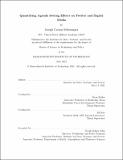Quantifying Agenda Setting Effects on Twitter and Digital Media
Author(s)
Schlessinger, Joseph Carson
DownloadThesis PDF (8.745Mb)
Advisor
Eckles, Dean
Kao, Ed
Terms of use
Metadata
Show full item recordAbstract
Agenda setting theory describes how the media influences which issues enter the public agenda. New technologies have disrupted media institutions and long-established agenda setting dynamics. This thesis studies agenda setting effects in two different ``new media'' environments: Twitter and digital media.
On Twitter, I study the impact of a coordinated, astroturfed campaign to elevate political hashtags favorable to the Bharatiya Janata Party (BJP) to the Trending Topics pages. While the astroturfed hashtags did reach \textit{trending} status, I find little evidence that the coordinated tweets were popular. The highly retweeted tweets within the hashtag come from users outside of the coordinated campaign, and they are semantically distinct from the coordinated tweets. I also study the effects of the Trending Topics page, one of Twitter's agenda setting tools. I find \textit{trending} may have a small causal effect on hashtag use. While I found that most hashtag engagement came organically from network spread rather than \textit{trending}, the Trending Topics page \textit{did} expose users less connected to the BJP Twitter community to the astroturfed hashtag..
In digital media, I study intermedia agenda setting, or the ability of media outlets to influence other outlets. I propose a novel pipeline for quantifying influence by tracing the diffusion of quotes across media outlets. While most outlets demonstrate limited influence outside of their country's media ecosystem, wire outlets are a notable exception. I find evidence of a Russian state media echo chamber, where outlets repeatedly follow each other's quotes. Outside of this echo chamber, Russian state media has some success in setting the boundaries (topics and quoted speakers) for other outlet's reporting, but they have little impact on the positions outlets take within these boundaries. Lastly, I compare the intermedia agenda setting capabilities of Russian and American state media.
Date issued
2021-06Department
Massachusetts Institute of Technology. Institute for Data, Systems, and SocietyPublisher
Massachusetts Institute of Technology